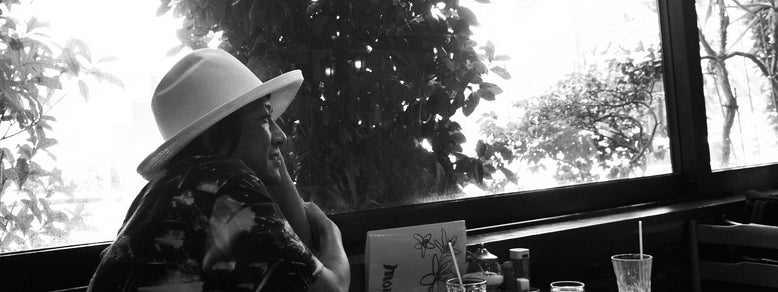
"特濃-TOKUNO BLUE" and
MOMOTARO JEANS
The blue jeans, once created as workwear, have long since become the centerpiece of the wardrobe,
defining individual style through the years.
Today, denim is a familiar and indispensable part of daily life for people around the world.
Yet, some untapped potentials and values can still be waiting to be discovered within its fabrics.
At MOMOTARO JEANS, rooted in the heart of denim craftspersonship,
we are dedicated to honoring tradition while pioneering the next generation of denim.
The deeper hues of indigo that grow richer with time,
the timeless appeal that never fades—like the beauty of that enduring blue, we strive to ensure that jeans always remain fresh and relevant.
PHOTO: Kousuke Matsuki / Kazumasa Takeuchi(Ye/product)
EDIT & TEXT: Rui Konno

The Story of Kojima,
the Story of MOMOTARO JEANS
The land of Kojima, whose name appears in Japan's oldest literature,
the "Kojiki," is located in the western part of Honshu, in Kurashiki City, Okayama Prefecture.
Until about 400 years ago, this area was a large island floating in the Seto Inland Sea. However, due to land reclamation, it became connected to the mainland, and the soil, rich in salt, became suitable for cotton cultivation. This gradually led to the development of today's thriving textile industry.
With the establishment of industrial machinery and the abundance of skilled technicians in the area, it is only natural that the denim culture would flourish here..
Still, it is possible that the people of this land once felt a unique connection to the depth of blue found in denim,
much like the shimmering sea, bathed in sunlight.


""Born in Europe, industrialized in America, and symbolizing freedom and rebellion,
jeans have now become one of Japan's most iconic products.
This fascinating story is what first drew me to Kojima.
In the Sanbi region, where denim craftspersonship thrives, each stage of production—spinning, dyeing, weaving, finishing, and sewing—is clearly specialized, with dedicated artisans committed to their craft. This area is truly a collective of craftspersonship.
In a world where automation is progressing rapidly,
I believe this region demonstrates strength born from a different kind of logic, one that transcends mere rationality.
MOMOTARO JEANS, a brand rooted in a fabric wholesaler in Kojima, was founded in 2006.
Today, we are proud to have skilled technicians who perfectly handle rare old-fashioned shuttle looms,
tailors well-versed in tailoring, and artisans specializing in indigo dyeing
—all of whom carry a deep sense of pride and passion for their work.
Personally, I was introduced to denim in my youth, and I still wear it today.
However, if I may be bold, neither we nor the artisans are chasing nostalgia.
We are focused on denim as a high-quality product, not just as a fashion statement. Our goal is to create new ways of enjoying it,
to surprise those who wear it, and to change the conventional wisdom surrounding jeans.
Our mission is to pass down the traditions of this land and the artisans' craftspersonship to the next generation.
Demonstrating that their passion for innovation itself is a form of tradition, and ensuring that it never fades.
No matter how advanced technology and machinery become,
we believe that truly great products are ultimately created by human hands.
This commitment to craftspersonship is the very essence of MOMOTARO JEANS."
— Masataka Suzuki, CEO of Japan Blue Co., Ltd.
(Japan Blue Co., Ltd. President and CEO, Masataka Suzuki)

Bluer than indigo—"特濃-TOKUNO BLUE", the deepest shade of blue.
The denim that symbolizes MOMOTARO JEANS is characterized by an incredibly deep and rich blue. This intensity of color not only enhances the intrigue of aging but also makes the contrast of fading more beautiful and pronounced. Here, we will unravel the secret behind this unique shade of blue, known as "特濃-TOKUNO BLUE."

A rare weave density of "67 threads."
Typical denim fabric is woven from indigo-dyed warp yarns and white weft yarns. The blue of denim comes from the warp yarns, and the fading of jeans occurs through the gradual wear of these warp threads. While the standard density for warp yarns is about 64 threads per inch, the "STANDARD" series by MOMOTARO JEANS features a denser weave with 67 threads per inch. This increased density reduces the amount of white weft yarn visible through the fabric, resulting in a significantly deeper and more intense color. A testament to MOMOTARO JEANS' dedication to blue and their expertise in weaving, this represents a fresh approach to denim.

1. "STANDARD"

2. "CLASSIC"
On the left is the "STANDARD" series, and on the right is the "CLASSIC" series, which embodies the authentic character of vintage. When compared to the latter's authentic texture, it becomes clear just how much deeper the tone of the "STANDARD" series is.
Repeated dyeing and "A Kind of Blue."
Many of the denim fabrics used by MOMOTARO JEANS are dyed at Kaihara, a renowned denim production dyeing company based in Hiroshima Prefecture with over 130 years of history. The company supplies fabric to prestigious global maisons as well as popular domestic and international brands. However, the warp yarns used for MOMOTARO JEANS are distinct from others. The difference lies in the dye developed through a collaborative effort, inspired by the blue hues derived from indigo, and the unique number of dyeing processes applied.

The warp yarns, before being dyed, are bundled into groups of around 500 to 600 threads and wound onto a drum. By the time of the winding process reaches approximately 7,000 yards of thread, it forms a large mass known as a sizing ball. Once it is placed in the dyeing machine, the first step involves a pre-treatment process where the yarns are washed and rinsed to remove any oils or impurities.


The yarns, freshly dyed with indigo, initially have a strong yellowish hue. As they come into contact with air, they gradually oxidize and take on a blue tint. At Kaihara's dyeing facility, the yarns are repeatedly moved between the indigo vats and the air, a process that deepens the blue as the yarns pass through. By repeating this process more times than usual, MOMOTARO JEANS achieves its uniquely deep blue, a shade that would be nearly impossible to produce through standard methods.


The gradient effect visible on the yarns is created as they repeatedly move between the floor and the ceiling of the facility during the dyeing process. As the yarns progress to the right, it becomes clear that the intensity of the blue deepens. Even in its fully dyed state, the characteristic white core of rope-dyed yarns can still be seen. This core plays a crucial role in achieving the beautiful fading effect that will emerge once the fabric is made into a finished product.


After several rinsing cycles to stabilize the pH, the color is fixed. The yarns are then dried by being wrapped around a cylinder through which steam is passed. Once dried, the warp yarns are complete and ready to be shipped to the weaving factory.
Through a series of specialized processes and the expertise and collaboration of many craftsmen, MOMOTARO JEANS products are created. With innovation and dedication, we bring a sense of freshness and joy to everyday wear.
MOMOTARO JEANS remains at the forefront, pushing the boundaries of denim craftspersonship as the industry’s challenges continue to evolve.









